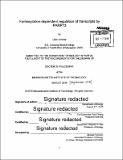Farnesylation-dependent regulation of transcripts by PARP13
Author(s)
Uchima, Lilen
DownloadFull printable version (11.98Mb)
Other Contributors
Massachusetts Institute of Technology. Department of Biology.
Advisor
Paul Chang and Stephen P. Bell.
Terms of use
Metadata
Show full item recordAbstract
PARP1 3 is a RNA-binding and catalytically inactive member of the poly(ADPribose) (PARP) family. PARP13 was first identified as a host antiviral factor that selectively binds to viral mRNAs and targets them for degradation by mRNA decay factors. Recently, functions of PARP13 in post-transcriptional regulation of cellular mRNAs were identified. In this context, PARP13 indirectly regulates the miRNA silencing pathway, restricts human retrotransposition by regulating LINE-1 mRNA and downregulates the mRNA levels of TRAIL-R4 -a pro-survival TRAIL ligand receptor. Farnesylation is a post-translational lipid modification that causes proteins to associate to membranes and is required for the activity of some proteins such as Ras. Farnesyl modification adds a 15-carbon prenyl group to the C-terminus of proteins, including PARP13, that contain a CaaX motif. Because PARP13 has two splice isoforms, the full-length PARP13.1 and the C-terminal truncated isoform PARP13.2, only the full-length isoform PARP13.1 is farnesylated. Here we show that PARP13.1 localizes to the cytoplasm and the endoplasmic reticulum and binds RNA at both compartments. Localization to the ER is mediated by farnesylation of cysteine 899 and to a lesser extent to RNA interactions through its CCCH zinc fingers. We also identify a set of putative PARP13.1 cellular mRNA targets by differential expression analysis of PARP13-/- cells expressing either full length PARP13.1, a RNA binding mutant (PARP1 3 .1VYFHR) or a farnesylation mutant (PARP13.1C899s). Most of the transcripts that are regulated in a PARP1 3.1-dependent manner are membrane-associated and require the farnesylation of PARP13.1 for their regulation. These results possibly suggest that localization of PARP1 3.1 to the ER by farnesylation is important for the regulation of mRNAs that localize there. We furthermore, validate the regulation of CERK and DNER, two cellular mRNAs targets by PARP13.1. In addition we determine that the PARP13-dependent regulation of the transcript DNER affects neurite outgrowth in the human cell line U87-MG, possibly implicating PARP13.1 in yet another important cellular process such as neuritogenesis.
Description
Thesis: Ph. D., Massachusetts Institute of Technology, Department of Biology, 2015. Cataloged from PDF version of thesis. Includes bibliographical references.
Date issued
2015Department
Massachusetts Institute of Technology. Department of BiologyPublisher
Massachusetts Institute of Technology
Keywords
Biology.